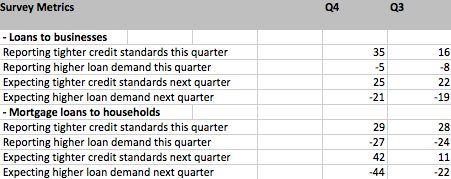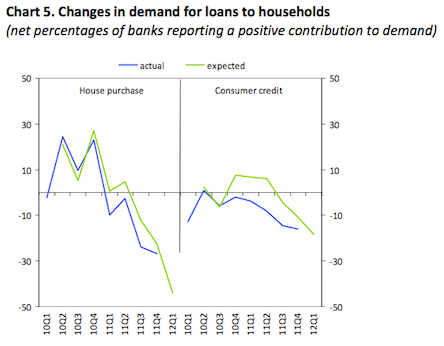Over the last few weeks I have mentioned a number of times in posts and comments that the ECB’s 3-year LTRO may not have been as successful as hoped because it was failing to do what central bank operations are designed to do, that is transfer monetary policy into the real economy. With rates so low what you would normally expect to see in the private sectors of Europe is a higher demand to give/demand credit. However, as I showed on Monday, the latest monetary aggregates from the Eurozone suggest that in fact the reverse is happening.
This is not really a surprise given that the two restrictions on bank lending are banking capital and credit-worthy customers and both are under pressure in the euro area due to the combination of higher capital requirements under Basel III and struggling periphery economies. However, as noted by Moody’s in a recent report, a sudden fall in the demand for credit in the private sector can lead to some very serious economic outcomes, especially when the entire system is already highly leveraged:
… if banks extend less credit to governments, businesses and households, this can curb economic activity, with adverse implications for borrowers’ payment ability and ultimately for bank asset quality and solvency.
At the beginning of January I wrote a post of what I saw as a coming “zombification” of the Eurozone banking system in which financial institutions use the ECB’s 3-year LTRO to provide them with liquidity while they shrink their balance sheets in order to meet capital requirements. This “zombification” would ultimately mean that banks would be far less likely to offer credit to the private sector which would already have a subdued demand for it. As I have noted several times, these two things combined with government austerity risk sending parts of the Eurozone private sector into a deflationary spiral.
Last night the ECB released its bank lending survey for January ( available below ) which once again suggests that the worst is yet to come for periphery Europe. The survey was conducted from the 19th of December through to the 9th of January on a sample of 124 banks across the region. The ECB’s 3-year LTRO occurred on December 22nd, so although its full effect may not be reflected in the survey, the operation would have certainly influenced the bank’s responses.
The survey points to a severe credit squeeze across the Eurozone. However, as we have seen with so much of the recent data, the brunt of the bad news can be found away from the European “core”. Most concerning is that the survey clearly shows that banks are imposing significantly harsher loan terms on the private sector and that demand for credit is tumbling.

According to the January 2012 bank lending survey (BLS), the net tightening of credit standards by euro area banks surged in the fourth quarter of 2011 for credit standards on both loans to non-financial corporations (35% in net terms, up from 16% in the preceding quarter) and loans to households for house purchase (29%, up from 18% in the preceding quarter), and to a lesser extent on consumer credit (13%, up from 10% in the preceding quarter). Looking ahead, euro area banks expect a further net tightening of credit standards, albeit at a slower pace than in the fourth quarter of 2011.
Participating banks explained the surge in the net tightening of credit standards by the adverse combination of a weakening economic outlook and the euro area sovereign debt crisis, which continued to undermine the banking sector’s financial position. Increased market scrutiny of bank solvency risks in the fourth quarter of 2011 is likely to have exacerbated banks’ funding difficulties. As a result, euro area banks significantly tightened credit terms and conditions and raised interest rates on loans to non- financial corporations (NFCs) and households. The prevalence of tightening appeared to be widespread across larger euro area countries, with the notable exception of Germany.
….
According to the January 2012 BLS, the net tightening of banks’ credit standards on loans to non- financial corporations surged in the last quarter of 2011, to 35% from 16% in the preceding quarter . This is higher than anticipated by survey participants at the time of the previous survey round (when it stood at 22%). In net terms, the tightening of credit standards appears to have been applied more to large firms than to small and medium-sized enterprises (SMEs).
….
In the last quarter of 2011 net demand for loans to NFCs was reported to have declined further, albeit to a lesser extent than in the previous quarter (-5%, compared with -8% in the third quarter of 2011; This decline was driven by a moderation in the pace of economic activity, as reflected by the slightly negative contribution of financing needs linked to inventories and working capital. More importantly, the need to finance fixed investment fell sharply (-20% in net terms, compared with -6% in the previous quarter).
…
Euro area banks also reported a strong further contraction in the demand for mortgage loans in the last quarter of the year (-27% in net terms, from -24% in the preceding quarter; ). This was mainly on account of a clear deterioration of housing market prospects (-27%, compared with -22% in the previous survey round) and weakening consumer confidence (-34%, compared with -24% in the preceding quarter). Financing needs for non-housing consumption, household savings and competitive pressures were also reported to contribute negatively to the demand for mortgage loans, although in proportions similar to in the previous survey round. Looking ahead, 44% of euro area banks (in net terms) expect demand for loans for house purchase to decline further in the first quarter of 2012. The decline in expectations for mortgage demand was broadly based across nearly all euro area countries, with a strong deterioration (i.e. above 20 percentage points) in Spain, Italy, Belgium, Finland, Malta and the Netherlands.
….
Net demand for consumer credit fell to -16% in the fourth quarter of 2011, from -15% in the previous survey round. This fall was mainly explained by lower household spending on durable goods (-20% in the last quarter of 2011, compared with -14% in the preceding survey) and a decrease in consumer confidence (to -20% in the last quarter of 2011, from -18% in the third quarter). Looking forward, in the last quarter of the year, euro area banks continued to expect negative developments in net demand for consumer credit (-18%).

The timing of the survey may have been premature in allowing for an accurate determination as to whether the latest “emergency” measures have been effective and therefore it is possible that the expectations of the banks were in fact too bearish. Let’s hope that is the case because the deceleration of both appetite to lend and demand for credit shown in the survey suggest the downturn in the European periphery has only just begun and has the potential to be far worse than many are predicting.